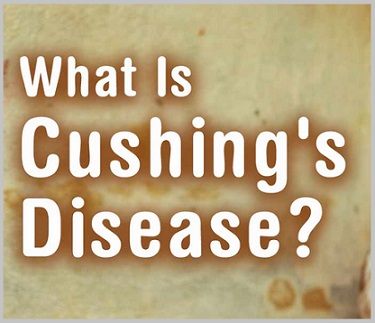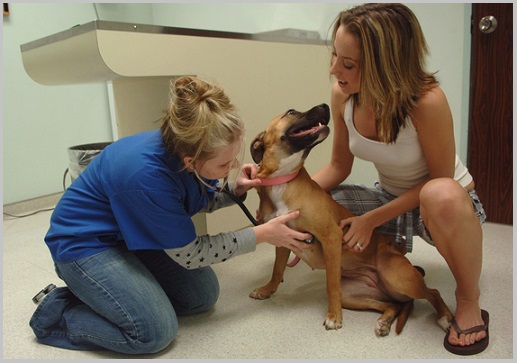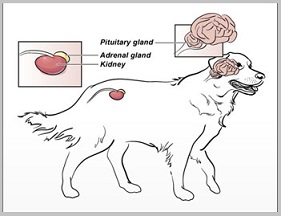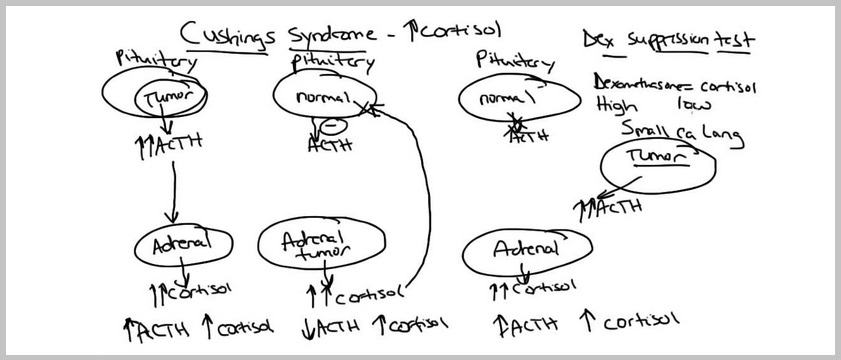Table Of Contents
Cushing's Disease In Golden Retriever Dogs
Cushing's disease in Golden Retriever dogs is a very complicated condition with a wide range of symptoms and treatments. Let's see if we can boil it down to the basics.
This disease is actually quite common in dogs.It's usually found in dogs that are middle-aged or older.
Small dogs usually develop the condition between the ages of eight and ten. Larger dogs show signs around six years of age. Females seem to be at a slightly higher risk than males.
Although all dogs are at risk, some breeds are at greater risk.
These include the following: Poodle, Beagle, Boxer, Dachshund, Miniature Schnauzer, German Shepherd, Golden Retriever, Labrador Retriever, Yorkshire Terrier, and terriers in general.
By the way, Cushing disease in humans is rare.
[AdSense-A]
What is Cushing's Disease In Dogs?.

You might also see this condition referred to as "Cushing disease in dogs" or "canine Cushing disease" (leaving off the apostrophe and s). I'll use the correct term in this explanation (Cushing's disease in dogs).
Simply put, Cushing's disease is a condition in which a dog's adrenal glands produce too much cortisol. So what does that really mean?
Let's start with the adrenal glands. They're a pair of inch-long kidney-bean-shaped glands situated just above the kidneys.
They manufacture and secrete hormones directly into the blood stream to help regulate a whole bunch of bodily processes. One of the most important hormones is cortisol.
The whole cortisol process actually starts in the hypothalamus (in the brain), which communicates with the pituitary gland (at the base of the brain).
The pituitary gland then uses a chemical (ACTH) to tell the adrenal glands how much cortisol to make and when it should release it into the body.
Everything's running smoothly until the cortisol delivery system gets a kink in it, throwing the whole body out of whack.
Your dog's pituitary keeps cranking out ACTH, telling the adrenals to keep cranking out cortisol.
What's the result? Your dog is essentially being poisoned with too much cortisol.
Symptoms of Cushing's Disease In Dogs
So how does this excess cortisol affect your Golden Retriever dog?
Unfortunately, many of the symptoms of Cushing's disease in dogs show up gradually and progress slowly, causing most owners to think their dog is just going through the typical changes of "old age."
The most common symptoms associated with Cushing's disease in dogs have to do with water.
Your dog drinks lots more water and has to go potty a lot more than he used to.
Dogs might start having accidents in the house because their bladders hit "overflow" before they can get outside.
But because they usually have a great appetite (voracious, actually), their owners think they're healthy (though slightly incontinent).
Besides the increased thirst, urination and appetite, here are a few more symptoms of Cushing's disease in dogs that a pup might experience:
- Pot-bellied appearance.
- Heavy panting.
- Thinner skin.
- Chronic skin infections.
- Wounds that don't heal well.
- Lethargy.
- Muscle weakness.
- Less interest in people.
- Calcium deposits (bumps) on the skin.
- Recurrenturinary tract infections.
- Massive shedding, mainly on the body (not head or legs).
- Sleeping more during the day, restless at night.
- Seeking out cool sleeping surfaces (bathroom tiles, etc.).
Different Kinds of Cushing's Disease In Dogs
The cortisone communication system has gotten messed up for one of three reasons: a pituitary tumor, an adrenal tumor, or veterinary interference.
In 85% of the cases of Cushing's disease in dogs, a tumor in the pituitary gland causes it to crank out more ACTH than it should, which forces the adrenal gland to produce more cortisol than it needs to.
The other 15% of the time, a tumor in the adrenal gland causes excess cortisol to flow into the dog's system.
That adds up to 100% of the cases in which a dog gets Cushing's disease due to a "system malfunction."
But there's one more situation we need to mention. The third type--called Iatrogenic Cushing's disease in dogs--is one that we can create ourselves if we give a dog too much cortisone, especially for chronic conditions like allergies.
Although the cortisone injections or tablets were given for a legitimate medical reason, they're now doing more harm than good.
[AdSense-A]
Diagnosing Cushing's Disease In Dogs

Your vet will use your dog's medical history, a physical exam, and the results of initial blood and urine tests to try to confirm or rule out Cushing's disease.
More specific tests are then done to confirm the diagnosis and to determine the type of Cushing's disease your dog has.
It could be either pituitary-dependent or adrenal-dependent. Your vet needs to know which kind it is before he can treat it.
It's important to get the ball rolling as soon as possible.
Left untreated, Cushing's disease in dogs will progress and can lead to life-threatening disorders such as diabetes, congestive heart failure, and liver and kidney failure.
Treatment For Cushing's Disease In Dogs.
The type of treatment your Golden Retriever dog receives depends on which of the two organs (the pituitary or the adrenal gland) has the abnormality.
Case of Adrenal gland.

In theory, this can cure adrenal-based Cushing's disease, and the future looks bright for dogs with benign adrenal tumors. Unfortunately, 50% of adrenal tumors are malignant.
These malignant ones don't respond to radiation or chemotherapy, as the amount of drugs necessary would cause unacceptable side effects.
If the malignant cancer hasn't spread to other parts of the body, it might be possible to remove it surgically.
However, by the time this type of Cushing's disease is diagnosed, it's usually too late to perform surgery.
Case of Pituitary.
In contrast, pituitary-dependent Cushing's disease is often successfully treated with medication. Since the pituitary gland is located in the center of the brain, it's nearly impossible to surgically remove tumors there, so medical therapy is the treatment of choice.
Medications are available that destroy part of the adrenal gland. The pituitary gland is still telling the adrenal gland to produce cortisol. But the adrenal gland is unable to comply. That means the dog isn't actually cured.
But control is possible for many years through ongoing medication and careful monitoring.
In the past few years, another drug has been introduced to treat pituitary-dependent Cushing's disease in dogs. This drug (Anipryl) doesn't destroy adrenal gland tissues.
Instead, it helps restore function of a normal chemical in the brain (dopamine). That helps slow down excessive ACTH production.
Anipryl seems to not only reduce Cushing's disease symptoms, but even helps many dogs regain their lost energy over a period of time. And since it isn't a form of chemotherapy, it doesn't have the usual adverse side effects of such drugs.
Let's not forget about Iatrogenic Cushing's disease.
When cortisone medications have been given long-term, they must be discontinued gradually to give the body time to get used to properly regulating its metabolism again.
The down side in this situation is that it usually results in a recurrence of the condition that was being treated by the cortisone (arthritis or allergies, for example), possibly reducing the dog's quality of life.
[AdSense-A]
Can Cushing's Disease In Dogs Be Prevented?
At this time, there is no known way to prevent Cushing's disease in dogs. However, some preventive measures may lead to earlier diagnosis and potentially more effective treatment:
- As your dog gets older, twice-yearly visits to the veterinarian may identify early symptoms of the disease.
- Running routine blood tests in older dogs may identify laboratory abnormalities associated with canine Cushing's disease.
- Monitor your dog for any changes in behavior or attitude, especially increased drinking, urination, and appetite. Don't justassume any such behavior is because he's getting old!.
Keep this in mind: Although most pets with Cushing's disease in dogs can't actually be cured, their quality of life can be improved, and their lives may be extended with early intervention.
Similar Articles :
1- Golden Retriever Lifespan .
2- Tramadol For Dogs Toxicity.
3- Can Dogs Eat Grapes Or Not?? .
4- Golden Retriever Breed Standard.
5- Find Good Golden Retriever Forum.
6- How To Stop Your Dog From Biting .
7- My Dog Ate Chocolate What Should I Do? .
8- Golden Retriever Health Problems Issues.
9- How To Deal With An Golden Retriever Dog.
10- How To HOW TO STOP YOUR DOG FROM BITING.
11- Worming / Deworming Your Golden Retriever Puppies.
12- How To Deal With An Aggressive Golden Retriever Dog.
13-The Rabies Reality : Are Golden Retrievers Susceptible To Rabies
14- The Phases Of Rabies & Preventative Measures For Golden Retrievers
